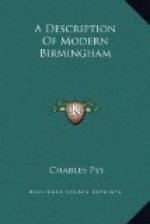CHRIST CHURCH.
The land whereon this edifice is erected was the gift of William Phillips Inge, Esq. whose ancestors about a century ago generously gave the scite upon which the church of St. Philip’s stands. It is situated at the upper end of New-street, and the first stone of it was intended to have been laid by his present majesty, George the 3d, in person; but it having pleased the Almighty to afflict him with indisposition, that ceremony was performed by the Earl of Dartmouth, on the 22d of July, 1805, in presence of the bishop of the diocese, who was attended by numbers of the nobility, clergy, gentry, the trustees appointed under the act of parliament, and a numerous assemblage of the inhabitants. Although his majesty’s malady did not admit of his being present upon this occasion, as it is understood he very much wished to be, he in a very condescending manner gave directions for the payment of one thousand pounds, from his private purse, towards the completion of the building. The body of the church being free to all description of persons, is fitted up with benches for their accommodation; but rent being paid to the clergyman for kneelings in the galleries, they are finished in a style of elegance, with mahogany, supported by light pillars of the doric order. The church was consecrated with great solemnity on the 13th of July, 1813, by the Honourable and Right Rev. James Cornwallis, bishop of Lichfield and Coventry, and an appropriate sermon preached by the Rev. Edmund Outram, D.D. the worthy rector of St. Philip’s church, who selected his text from one of the beatitudes—“The poor have the gospel preached unto them.”—The bishop, in whom the presentation rests, afterwards gave to the Rev. J. Hume Spry, whom he had appointed to the living, the sum of one hundred pounds, to purchase bibles and prayer books, for the use of the congregation, or that part of it whom he perceived to be the most regular in their attendance. Divine service was first performed by the aforesaid clergyman, on Sunday the 18th of July, at half past ten o’clock in the morning, and in the evening at six o’clock. The ascent to the galleries is by a double geometrical staircase, of stone, with ballustrades of iron, coated with brass, which appear light and produces an elegant




